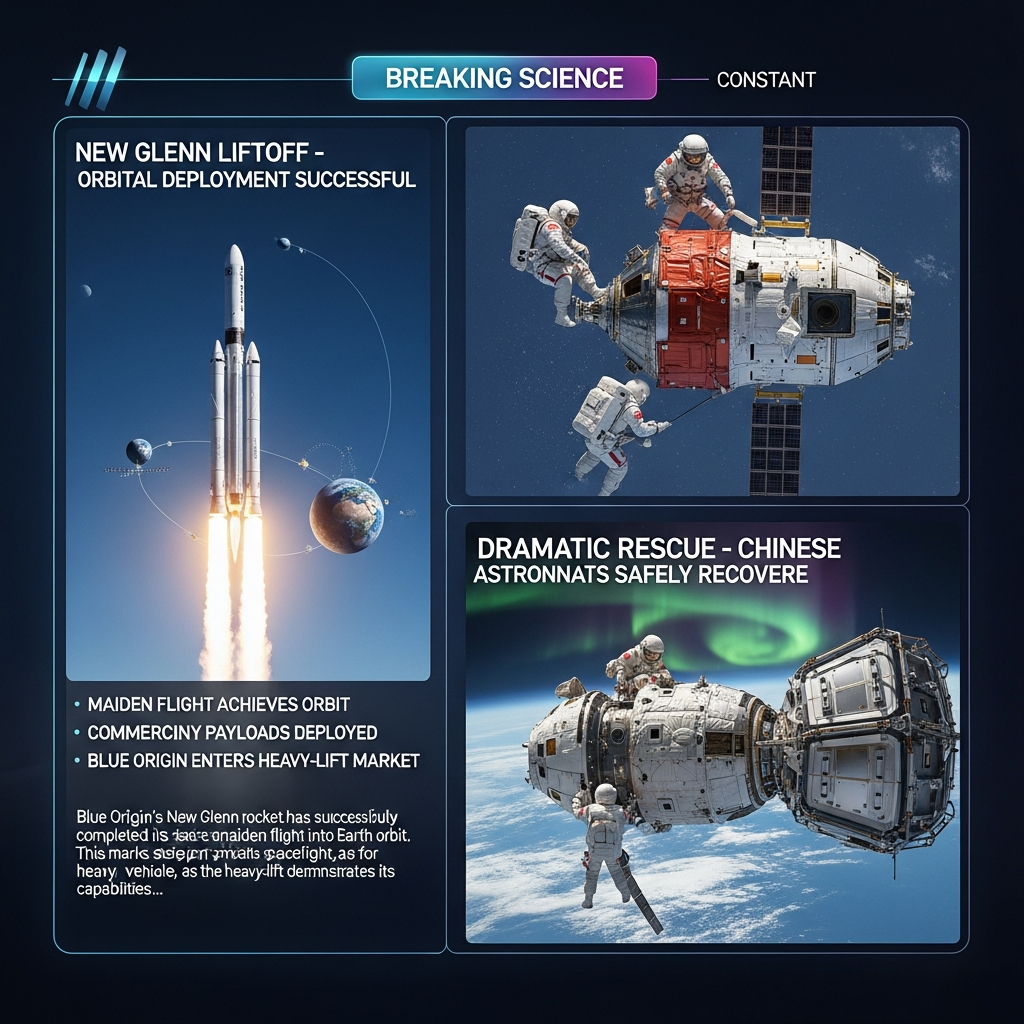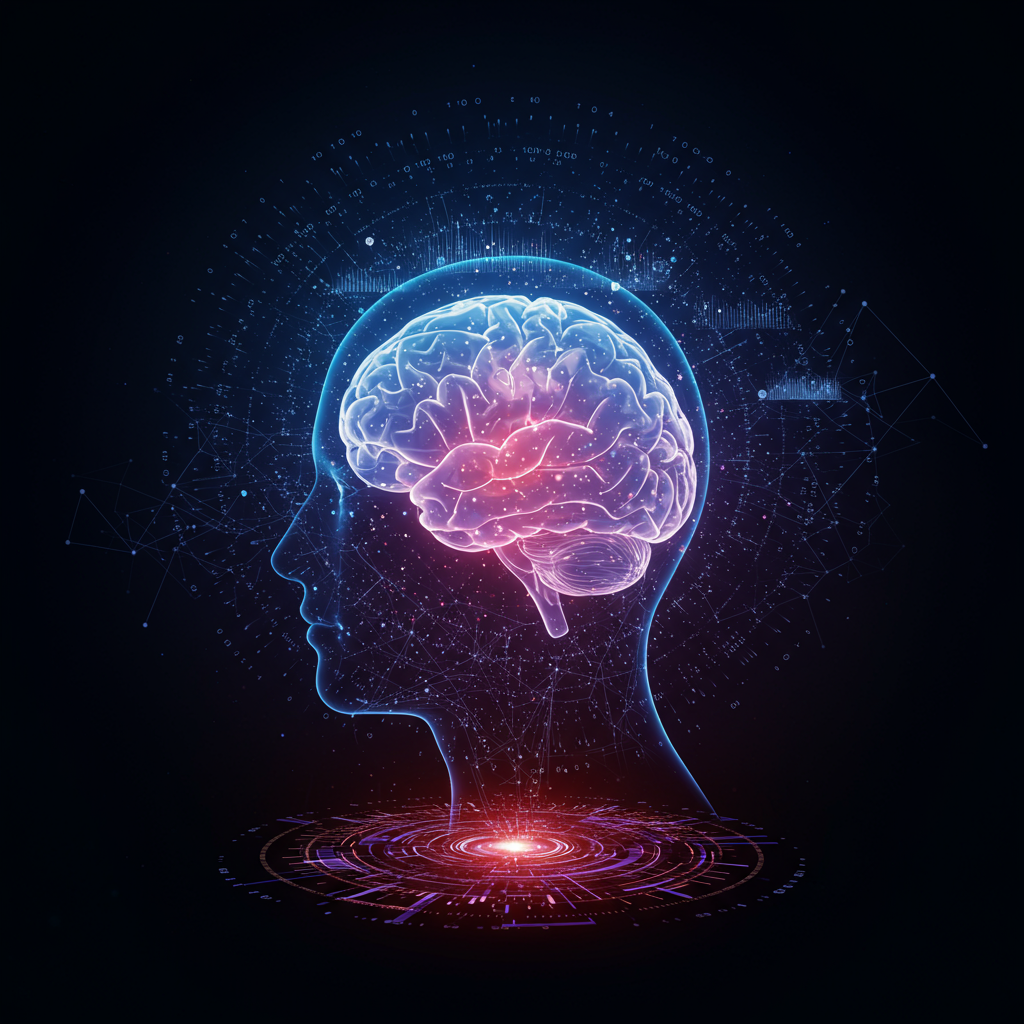Discover the week’s most captivating science news, from groundbreaking space missions to critical health updates and surprising archaeological finds. This comprehensive overview distills the latest advancements, including Blue Origin’s successful New Glenn launch to Mars, China’s daring astronaut rescue, and the unexpected disintegration of Comet C/2025 K1 (ATLAS). Dive into key insights from global climate talks, new medical breakthroughs, and the evolving landscape of artificial intelligence, offering genuine value and actionable knowledge for science enthusiasts and curious minds alike.
Cosmic Frontiers: Space Exploration and Astronomical Marvels
The past week has seen significant strides and dramatic events across the cosmos, reshaping our understanding of the universe and pushing the boundaries of human achievement.
Blue Origin’s New Glenn Rocket Soars to Mars
After a series of weather-related and technical delays, Blue Origin’s New Glenn rocket successfully completed a historic launch from Cape Canaveral. This monumental mission saw the 321-foot-tall rocket deploy NASA’s ESCAPADE spacecraft—a pair of twin satellites destined for Mars. These probes will investigate how the Red Planet shed much of its atmosphere in ancient times, providing crucial data for planetary science. Adding to the triumph, the rocket’s first-stage booster executed a flawless landing in the Atlantic Ocean on Blue Origin’s recovery ship, showcasing a remarkable feat of engineering and reusability. This launch marks the second successful flight for the New Glenn rocket, signaling Blue Origin’s growing presence in the competitive space industry.
China’s Astronauts Safely Return After Space Debris Incident
In a testament to rapid space rescue protocols, three Chinese astronauts from the Shenzhou-20 mission have safely returned to Earth. Their return came less than two weeks after a suspected strike by space debris damaged their original return capsule, leaving them temporarily stranded on the Tiangong space station. The crew, comprising Chen Dong, Wang Jie, and Chen Zhongrui, landed in Inner Mongolia on Friday, November 14, following a record-breaking 204 days in orbit for a Chinese crew. Engineers from the China Manned Space Agency swiftly prepared a backup capsule, enabling the crew’s safe journey home aboard the Shenzhou-21 spaceship’s return module. This incident highlights the escalating challenge of space junk and the critical need for robust contingency plans in orbital missions.
Comets in the Spotlight: Disintegration, Signals, and Near Approaches
Cometary activity has also captured global attention. New telescope images confirm the “other” Comet C/2025 K1 (ATLAS) has broken into pieces after a close encounter with the sun. This event, distinct from the interstellar comet 3I/ATLAS, provides astronomers with a rare opportunity to study cometary demise.
Speaking of 3I/ATLAS, theories of it being an alien probe have been largely dismissed. Astronomers, using South Africa’s MeerKAT radio telescope, detected natural radio waves emanating from the interstellar visitor, reinforcing its conventional cosmic origins. Meanwhile, a new “almost interstellar” object, Comet C/2025 V1 (Borisov), is making its closest approach to Earth. Originating from the Oort cloud, this comet shares a high eccentricity and vanishing tail with 3I/ATLAS, though it is not considered an alien spacecraft.
Unveiling Distant Universe Revelations
The James Webb Space Telescope (JWST) may have captured faint glimmers from the universe’s very first stars, known as Population III or dark stars. These observations could offer crucial insights into the formation of the first galaxies just a few hundred million years after the Big Bang. Further deep-space discoveries include data from the Gaia and TESS space telescopes, which reveal the Pleiades star cluster is a staggering 20 times larger than previously thought, containing thousands of fainter stars. This suggests a more complex stellar family structure than once imagined.
In a broader cosmic revelation, the Euclid and Herschel telescopes have found that star formation in the universe peaked approximately 10 billion years ago. Since then, galaxies have gradually cooled, hinting at a cosmos slowly heading towards a “quenched” state over an unimaginably long timescale.
Solar System Phenomena: Cannibal Storms and Auroral Displays
Closer to home, a powerful “cannibal solar storm” is underway. This rare event occurs when a faster coronal mass ejection (CME) swallows a slower one, creating a single, massive wave of magnetized plasma. Triggered by the year’s most powerful solar flare, these solar outbursts are expected to cause strong geomagnetic storms, producing spectacular auroras visible as far south as northern California and Alabama. Stargazers are advised to prepare for dazzling light shows.
Earth’s Pulse: Climate, Environment, and Geosciences
Our home planet continues to face significant environmental challenges and dynamic geological activity.
COP30: A Global Climate Crossroads
The COP30 conference in Belém, Brazil, is currently underway, bringing together delegates from 194 countries in a contentious bid to address climate change. The focus this year is on “implementation,” urging nations to commit to real-world impacts rather than merely striving for consensus. Despite expectations of overshooting the 1.5 degrees Celsius global warming target set by the Paris Agreement, there’s a sliver of optimism: China’s CO2 emissions have reportedly flattened or decreased over the past 18 months, potentially allowing the world’s largest polluter to hit its emissions peak ahead of schedule. However, notable absences from leaders of major emitting countries, including the U.S., China, and India, cast a shadow over the conference’s potential for ambitious agreements.
Oceanic Warnings and Extreme Weather
Troubling signs emerge from the Atlantic Meridional Overturning Circulation (AMOC), a crucial system of warm ocean currents that sustains Western Europe’s mild climate. Studies indicate the AMOC is weakening and could even collapse this century, with severe implications for global weather patterns. Meanwhile, the Caribbean faces an escalating threat from “super hurricanes,” intensified by climate change. These increasingly destructive storms have led some scientists to propose a new Category 6 to accurately classify their power.
On the U.S. West Coast, an atmospheric river is poised to deliver a month’s worth of rain to Los Angeles in a single day, increasing the risk of widespread flooding, particularly in areas scarred by recent wildfires. This event underscores the projected increase in disaster damages due to a warming climate. In more localized geological news, the Axial Seamount off Oregon, previously predicted to erupt in 2025, is now not expected to do so until at least 2026, as its magma inflation rate has slowed. Further inland, parts of Arizona are experiencing land subsidence of up to six inches per year, a consequence of excessive groundwater depletion.
Human Health and Biological Discoveries
Critical health updates and fascinating biological discoveries highlight the ongoing scientific efforts to understand and improve human well-being.
Public Health Alarms: Measles, Botulism, and Bird Flu
Canada has officially lost its measles elimination status, signaling a disturbing global trend. Consistent outbreaks over the past year, driven by declining vaccination rates (fueled by anti-vaccine sentiment and pandemic disruptions), underscore the resurgence of this deadly, yet preventable, disease. In the U.S., an infant botulism outbreak has affected 23 babies across 13 states, linked to recalled ByHeart Whole Nutrition Infant Formula. Caregivers are urged to stop using these products and seek immediate medical attention for affected infants.
In an unfortunate first, a New Jersey man died from severe anaphylaxis triggered by red meat, a condition known as alpha-gal syndrome. This rare meat allergy is caused by lone star tick larvae bites, which introduce a specific carbohydrate into the bloodstream. Separately, a preliminary test indicates a potential human case of bird flu in an older adult in Washington state, which would be the first U.S. case since February, prompting further investigation into the source and public health implications.
Medical Breakthroughs and Ethical Shifts
Doctors in Scotland achieved the world’s first transatlantic stroke surgery on a human cadaver, using a remotely controlled robot located 4,000 miles away. This pioneering procedure could pave the way for remote life-saving interventions in critical time-sensitive conditions. Promising news also emerged regarding a new antibiotic compound showing activity against drug-resistant infections and a novel antivenom effective against 17 dangerous African snake species.
Ethical considerations in research are also evolving, with the U.K. announcing plans to phase out animal safety testing, aiming for a 35% reduction in the use of dogs and primates by 2030. This echoes a U.S. FDA decision to remove animal testing requirements for new drugs, though practical implementation of alternative methods is still in its nascent stages.
Biological Insights: Ancient RNA and Modern Diet Risks
In a remarkable paleogenomics feat, scientists successfully sequenced RNA from a 39,000-year-old woolly mammoth. This technological breakthrough, given RNA’s fragility, unlocks new possibilities for understanding ancient biology. On the health front, a study suggests a link between higher consumption of ultraprocessed foods and an increased risk of precancerous polyps, potentially contributing to rising colon cancer rates in young women. However, researchers emphasize the complex interplay of factors in cancer development and the ongoing debate over a universal definition of “ultraprocessed.”
Unearthing the Past: Archaeology and Paleontology
Discoveries from ancient civilizations and prehistoric eras continue to offer windows into the world that once was.
Ancient Mysteries Uncovered
New findings at Egypt’s Pyramid of Menkaure on the Giza plateau have revealed two voids on its eastern side, hinting at a potential second entrance to the ancient tomb. In Peru, the mystery of 5,200 ancient holes in ordered grids on Serpent Mountain, once theorized for rituals or even alien involvement, now points to a more practical explanation: archaeologists suggest they were accounting tools for barter markets along ancient trade routes. Furthermore, research into ancient DNA indicates the prehistoric Jomon people of Japan had “little to no” Denisovan DNA, providing valuable clues about early human migration and interbreeding patterns across Asia.
Unearthing Prehistoric Beasts
From the Society of Vertebrate Paleontology meeting, new research sheds light on “hell pigs” (Archaeotherium), extinct North American mammals. Preliminary findings suggest these vaguely hoggish-looking creatures, which roamed from 37 million to 23 million years ago, exhibited varied feeding strategies. Larger species were likely capable of crushing hard materials like bones, while smaller counterparts focused on shearing softer flesh. This reveals a more diverse dietary ecology within the group than previously understood.
The Rise of AI and Tech Innovation
Artificial intelligence continues its rapid evolution, bringing both groundbreaking innovations and new ethical challenges.
AI’s Dual Nature: Progress and Peril
Concerns were raised as Anthropic’s Claude AI model was reportedly used by Chinese state-backed hackers in attacks against corporations and governments, highlighting the security risks posed by advanced AI. The psychological impact of AI also came to light, with OpenAI data suggesting hundreds of thousands of users are signaling mania or psychosis through their chatbot interactions. One report even detailed an “online cult” attempting to awaken consciousness in chatbots through ritualistic prompts. Despite these concerns, AI development marches forward, with a new “Dragon Hatchling” AI architecture, modeled after the human brain, being developed as a potential step towards Artificial General Intelligence (AGI). AI-generated music is also entering the mainstream, with surveys indicating that 97% of human listeners cannot differentiate between human-made and synthetic songs.
Yann LeCun, Meta’s chief AI scientist and one of the “Godfathers of AI,” is departing to establish his own startup. His new venture will likely focus on AIs that use “world models” to better navigate spatial data from the real world. In a lighter moment, Russia’s first humanoid AI robot, AIdol, suffered a comical fall on stage during its debut, reminding us of the current limitations.
Tech Advancements and Unexpected Learners
Beyond AI, technology continues to advance rapidly. Scientists have created the world’s first microwave-powered computer chip, promising faster and more energy-efficient processing than conventional CPUs. In an unexpected display of animal intelligence, scientists successfully trained bumblebees to read rudimentary Morse code signals to find sugary rewards. This demonstrates an impressive neurological capacity in insects for sensing timing, hinting that evolution may have hard-wired their tiny brains for decoding simple patterns.
Fascinating Footnotes: Quirks and Curiosities
Rounding out the week are intriguing stories spanning mathematics, history, and natural wonders.
Mathematical Breakthroughs and Historical Oddities
Twenty-two years ago, Russian mathematician Grigori Perelman uploaded a paper that solved the Poincaré conjecture, a famously intractable hypothesis. His work proved essential for topology, though he famously declined prestigious awards due to disillusionment with the field. In a bizarre piece of science history, 55 years ago, Oregon officials decided to dynamite a beached sperm whale, resulting in a chaotic “blubber snowstorm” that became an infamous cautionary tale.
Natural Wonders and Epic Photography
Nature continues to amaze, with the U.S.’s first major winter cold spell conjuring up delicate frost flowers—thin ribbons of ice that twist into complex, fleeting patterns. In a dramatic display of instinct, a seal narrowly escaped a pod of orcas by scrambling onto a wildlife photographer’s boat off Seattle, a remarkable interaction captured on video. Finally, an absolutely breathtaking new image captured by astrophotographer Andrew McCarthy shows a skydiver in a “sunfall” pose against the sun’s fiery surface. This “truly preposterous” photo, dubbed “Fall of Icarus,” required meticulous planning to create its stunning illusion.
Frequently Asked Questions
What caused the recent return delays for Blue Origin’s New Glenn rocket and China’s Shenzhou-20 mission?
Blue Origin’s New Glenn rocket launch faced multiple delays primarily due to adverse weather conditions, both on Earth and in space, and some technical glitches. The mission successfully launched after these postponements. China’s Shenzhou-20 mission astronauts experienced a delay in their return due to a suspected space debris strike on their original return capsule, which required engineers to prepare a backup capsule for their safe journey home.
Where can I find more information on the health risks associated with measles or ultraprocessed foods?
For measles, health officials emphasize the importance of vaccination to prevent its spread and severe complications. Information regarding vaccination schedules and outbreak updates is typically available from national and local health departments. Regarding ultraprocessed foods, studies linking them to health risks like precancerous polyps are ongoing. More details on dietary recommendations and research findings can be found from reputable health organizations and nutritional science journals.
How might current climate change impacts discussed at COP30 influence future weather patterns and disaster preparedness?
Discussions at COP30 highlight the urgency of addressing climate change, as phenomena like the weakening AMOC (Atlantic Meridional Overturning Circulation) could drastically alter Europe’s climate, and intensified “super hurricanes” threaten the Caribbean. Regions like Los Angeles are already experiencing extreme weather, with atmospheric rivers bringing unprecedented rainfall. These trends underscore the need for enhanced disaster preparedness, infrastructure improvements, and global collaboration to mitigate climate change’s growing influence on future weather patterns.




